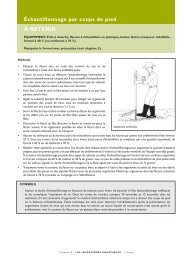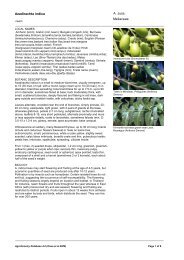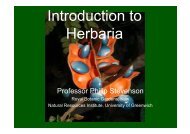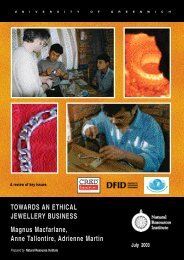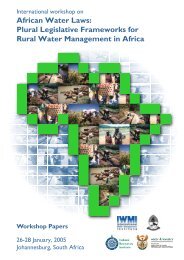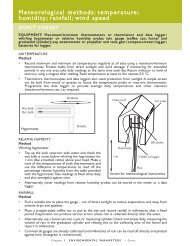botanical insecticides, deterrents, and repellents in modern ...
botanical insecticides, deterrents, and repellents in modern ...
botanical insecticides, deterrents, and repellents in modern ...
Create successful ePaper yourself
Turn your PDF publications into a flip-book with our unique Google optimized e-Paper software.
Annu. Rev. Entomol. 2006.51:45-66. Downloaded from arjournals.annualreviews.org<br />
by University of British Columbia Library on 12/09/05. For personal use only.<br />
62 ISMAN<br />
nicot<strong>in</strong>e from Nicotiana, methyl salicylate from Securidaca, <strong>and</strong> eugenol from<br />
Ocimum); some of these are volatile <strong>and</strong> act as natural fumigants that kill adult<br />
pests <strong>and</strong> their progeny (52). At least one study <strong>in</strong>dicates that these materials are<br />
relatively safe <strong>in</strong> the forms <strong>in</strong> which they are used (7). Some plant products could<br />
even be useful <strong>in</strong> <strong>in</strong>dustrialized countries for the protection of gra<strong>in</strong> from storage<br />
pests (33).<br />
Many of the plants discussed <strong>in</strong> this review are tropical <strong>in</strong> distribution <strong>and</strong> theoretically<br />
available to growers <strong>in</strong> develop<strong>in</strong>g countries. However, efficacy aga<strong>in</strong>st<br />
pests is only one factor <strong>in</strong> the adoption of <strong>botanical</strong>s—logistics of production,<br />
preparation, or use of <strong>botanical</strong>s can mitigate aga<strong>in</strong>st their use (68). Perhaps it is<br />
time to refocus the attention of the research community toward the development<br />
<strong>and</strong> application of known <strong>botanical</strong>s rather than screen more plants <strong>and</strong> isolate<br />
further novel bioactive substances that satisfy our curiosity but are unlikely to be<br />
of much utility.<br />
ACKNOWLEDGMENTS<br />
I thank NSERC (Canada) <strong>and</strong> EcoSMART Technologies, Inc., for support<strong>in</strong>g orig<strong>in</strong>al<br />
research on <strong>botanical</strong> <strong><strong>in</strong>secticides</strong> <strong>and</strong> antifeedants <strong>in</strong> my laboratory. Industrial<br />
colleagues <strong>in</strong> western Europe, Lat<strong>in</strong> America, <strong>and</strong> Australia provided <strong>in</strong>formation<br />
on registered <strong>botanical</strong> <strong><strong>in</strong>secticides</strong> <strong>in</strong> their regions.<br />
The Annual Review of Entomology is onl<strong>in</strong>e at http://ento.annualreviews.org<br />
LITERATURE CITED<br />
1. Akhtar Y, Rank<strong>in</strong> CH, Isman MB. 2003.<br />
Decreased response to feed<strong>in</strong>g <strong>deterrents</strong><br />
follow<strong>in</strong>g prolonged exposure <strong>in</strong> the larvae<br />
of a generalist herbivore, Trichoplusia ni<br />
(Lepidoptera: Noctuidae). J. Insect Behav.<br />
16:811–31<br />
2. Allan EJ, Eeswara JP, Jarvis AP, Mordue<br />
Luntz AJ, Morgan ED, Stuchbury T.<br />
2002. Induction of hairy root cultures of<br />
Azadirachta <strong>in</strong>dica A. Juss. <strong>and</strong> their production<br />
of azadiracht<strong>in</strong> <strong>and</strong> other important<br />
<strong>in</strong>sect bioactive metabolites. Plant Cell<br />
Rep. 21:374–79<br />
3. Antonious GF. 2004. Residues <strong>and</strong> halflives<br />
of pyrethr<strong>in</strong>s on field-grown pepper<br />
<strong>and</strong> tomato. J. Environ. Sci. Health<br />
B39:491–503<br />
4. Ascher KRS, Schmutterer H, Mazor M,<br />
Zebitz CPW, Naqvi SNH. 2002. The<br />
Persian lilac or ch<strong>in</strong>aberry tree: Melia<br />
azedarach L. See Ref. 81, pp. 770–<br />
820<br />
5. Atk<strong>in</strong>son BL, Blackman AJ, Faber H. 2004.<br />
The degradation of the natural pyrethr<strong>in</strong>s <strong>in</strong><br />
crop storage. J. Agric. Food Chem. 52:280–<br />
87<br />
6. Belma<strong>in</strong> S, Stevenson P. 2001. Ethno<strong>botanical</strong>s<br />
<strong>in</strong> Ghana: reviv<strong>in</strong>g <strong>and</strong> <strong>modern</strong>iz<strong>in</strong>g<br />
age-old farmer practice. Pestic.<br />
Outlook 12:233–38<br />
7. Belma<strong>in</strong> SR, Neal GE, Ray DE, Golob<br />
P. 2001. Insecticidal <strong>and</strong> vertebrate toxicity<br />
associated with ethno<strong>botanical</strong>s used<br />
as post-harvest protectants <strong>in</strong> Ghana. Food<br />
Chem. Toxicol. 39:287–91<br />
8. Bernays EA. 1990. Plant secondary compounds<br />
deterrent but not toxic to the grass<br />
specialist acridid Locusta migratoria: implications<br />
for the evolution of gram<strong>in</strong>ivory.<br />
Entomol. Exp. Appl. 54:53–56



